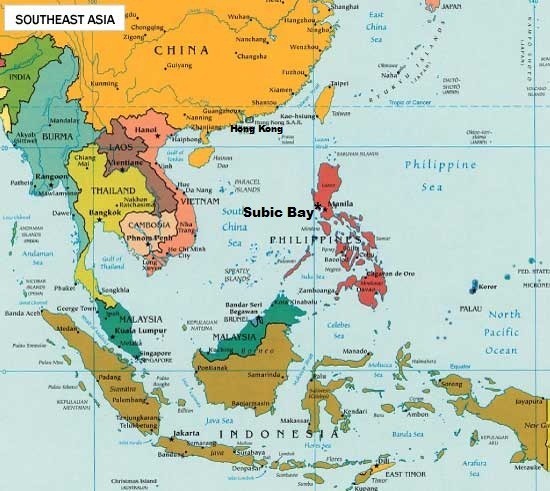Last March, The United States Marine Corps and Navy
conducted its annual training exercise Freedom Banner 2013 which displayed the expeditionary readiness of the U.S.
military. This bilateral exercise took place in Subic Bay, Republic of Philippines
and consisted of deploying a Marine Expeditionary Brigade as quickly as
possible. Two key components of this exercise were the prepositioning of supplies
and the rapid offload of cargo.
 |
| Subic Bay, Republic of Philippines |
Maritime Prepositioning Squadron III (MPSRON-3) of the The Maritime Prepositioning Force, which stands ready to respond quickly to anything
from the buildup of combat power to disaster relief, supported this operation.
The prepositioning of essential equipment and supplies throughout a region has
allowed the Marine Corps to extend its global reach. The time required to react
to a crisis is significantly reduced by prepositioning.
 |
| USNS Sacagawea (T-AKE 2) |
Another exciting aspect of Freedom Banner 2013 is the use of
the MV-22B Osprey as the
ship-to-shore connector. This operation utilized ship-to-shore sustainment including the USNS Sacagawea
(T-AKE 2) and the USNS 1st Lt Jack Lummus (T-AK 3011). MRE’s, fuel, construction equipment, ammunition, repair parts, vehicles, and generators were all be transported from the deck of the USNS Sacagawea to shore by the MV-22B Osprey. This was the first time that a III MEF Osprey conducted single and dual-point sling loads from a T-AKE. The Osprey was designed for expeditionary assault and has a cargo load of 20,000 lbs. It took less then 48 hours to move more than 270 Marine corps tactical vehicles and amphibious assault vehicles. The entire off-load of cargo usually takes three to four days.
 |
| MV-22B Osprey |
"What we wish, that we readily believe."
-Demosthenes
Freedom Banner 2013 does help to demonstrate how effective our military can be at projecting force, but will the U.S. be able to sustain this capability given its decreased funding and increased involvement in conflicts around the globe. There is potential for further U.S. involvement in conflicts in Syria, Afria, and in the Asia-Pacfic region. This may hamper our logistical capabilities in the future, if we have to deploy a force larger than a Marine Expeditionary Brigade. It is important to consider the potential impact that spreading ourselves too thin will have on our force as we attempt to strategically rebalance our forces. If we are unable to sustain our increased involvement in this region, we serve to hurt our credibility as the world's premier force projector.
ReplyDeleteIt is important to consider the repercussions of actually utilizing the Freedom Banner program to conduct combat operations in the Pacific. If the US becomes involved in any form of conflict, including disaster relief, the need for sustained operations over lenghty periods of time require the prepositioned supplies to have another set of prepositioned supplies to support them. The constant cycle of resupplying operations shows us that this program is only effective if the operation is very short.
ReplyDeleteI really liked your blog. Whenever I can pass by here to honor. It will be an honor for us to have him in our art blog.
ReplyDeleteTHE ART OF NEWTON AVELINO
http://www.aartedenewtonavelino.com
Brazilian art and culture